Introduction to Coat Care
The Norfolk Terrier Breed Standard describes the coat as ‘hard, wiry, straight, lying close to the body. Longer and rougher on neck and shoulders. Hair on head and ears short and smooth, except for slight whisker and eyebrows. Excessive trimming undesirable.’
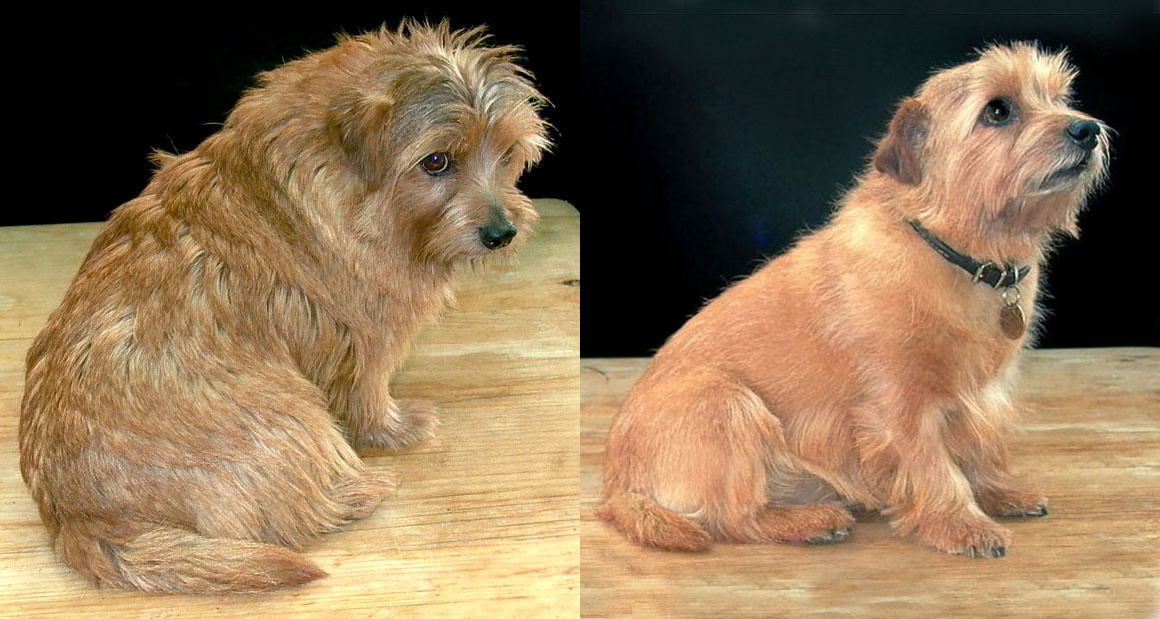
A Norfolk does not shed its coats naturally. If left, it will just grow more hair until it looks like an animated hearth rug; such a coat is neither warm nor weatherproof, it is unhealthy and very uncomfortable in hot and wet weather. In the snow it could be lethal because snow clings to the soft coat and forms huge balls on the legs and belly, which can prevent the dog from moving.
Norfolk coats are quite easy to manage but may have to be hand stripped about twice a year to remove the old blown coat to allow the new weatherproof coat to come through. A blown coat is long and shaggy and parts between clumps of hair - this coat has to be pulled out by hand, or with a special stripping knife. Norfolks with the correct coat should normally NEVER be clipped, as this will soften the harsh wiry coat that is a feature of the breed, make it woolly, very light in colour and no longer weatherproof.
A coat can be maintained for a considerable time by regular grooming and frequent ‘rolling’. This entails gently pulling out any paler, slightly longer hairs from the body coat every week with finger and thumb, or giving a quick skim over the neck and body with a stripping knife to keep the harsh outer weatherproof coat.
You can learn to strip your Norfolk yourself. The Norfolk Terrier Club of GB holds occasional grooming/stripping teach-ins where you can learn the skill. A video of a demonstration by Martin Phillips is also available from the Norfolk Terrier Club Stand. Otherwise go to a professional and INSIST on hand stripping.
Whilst a hard wiry coat is the ideal, some Norfolks do have softer and more profuse coats, and these can be kept tidy with a stripping rake, thinning scissors or the coat can be clipped by a professional. Occasionally a Norfolk will even have a fluffy coat. It is impossible and cruel to strip such a coat, and these dogs will have to be clipped.
Similarly, some older Norfolks may be sensitive to hand stripping and will find it more comfortable to be clipped but Norfolks are long lived so do not give up until you feel it is absolutely necessary.
Day to day care consists of keeping hair out of the dog’s eyes, scissoring long hair around the bottom of the feet and keeping the hair short under the tail for hygienic reasons. Groom with a normal brush and comb. The soft undercoat will normally take care of itself – some will come out with grooming, never try to remove it. Ears will keep their soft, velvety appearance if all pale straggly hairs are pulled out as they appear. It is important to keep the dog's coat clear of fleas and mites."
Warning 
Small tufts of the dead coat can be easily pulled out starting with the top of the head, down the neck, leaving a ruff of longer hair to frame the head just under the ears. Then work along to the tail, down both shoulders and sides, always going with the lay of the coat (the direction in which the hair grows.) The feet should be trimmed around underneath the pads, with the scissors flat to the pad, to form a neat shape. Long straggly strands from the legs can be gently pulled out, particularly shortening the hair by the elbows, but furnishing should be kept on the legs to give them a chunky look. The hair on the chest and belly can be just shortened a little to shape or tidied up with trimming scissors.
Cutting the hair very short, with scissors, in the area of the anus will ensure that there is no build up of debris under the tail. The tail itself should be stripped on the upper side, tactfully removing as many long hairs as possible from the sides with finger and thumb, and then tidied up the back, sides and top with scissors to avoid a flag.
Back to the head: with finger and thumb gradually take out all the pale straggly hairs from the outside and inside of the ears to leave a smooth dark velvet appearance. Don’t worry if the ears appear a little bald after stripping, the hair will grow back very soon. Scissors may be used around the ear hole to remove the sticking out bits. With finger and thumb pull out any straggly long hairs that stick up above eyebrows and shape. Similarly, gently remove one by one any hair going into the eyes. The moustache and beard can be tidied and shaped with trimming scissors.

1. An illustration of the equipment used for stripping out and grooming a Norfolk. Note the hand – finger and thumb are a vital bit of kit - wire brush, combs, stripping knives, one coarse (yellow) one finer (red), scissors, thinning scissors, double sided, smallest mesh available. Brush, finger and thumb, and pumice stone (which can be used to help grip the hair.)

2. This is a Norfolk ready for stripping, showing a blown coat that is long, soft and shaggy and which parts between clumps of hair;

3. With stripping knife, or finger and thumb, strip head in an inverted ‘V’ from the forehead between the eyes to ears, leaving the eyebrows.

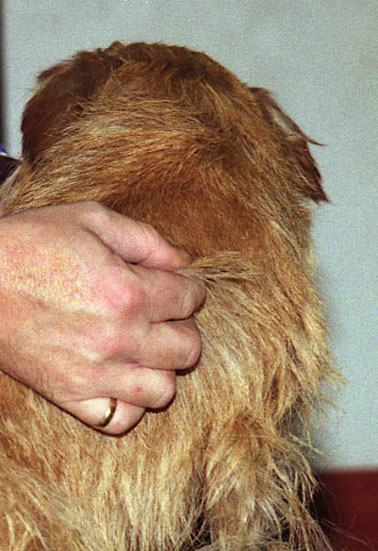

4. Strip down the centre of the neck and back towards the tail, gradually working down each side over shoulders and loins. Always follow the direction in which the coat grows.

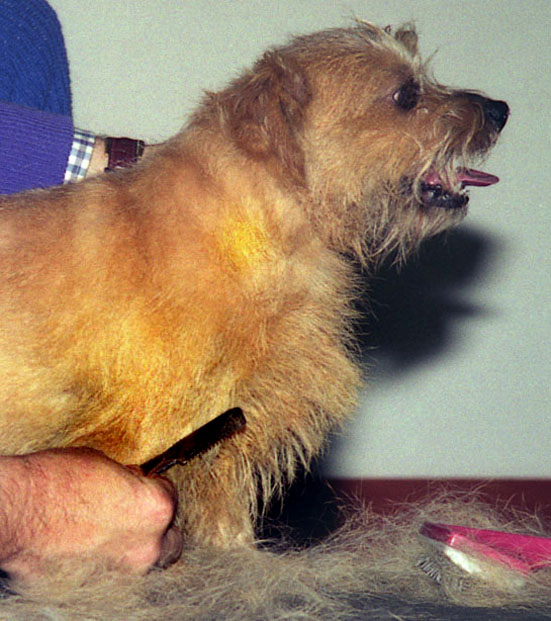
5. Strip down towards front legs in line with the elbows. Furnishing should be left on the legs and under the belly.


6. Support back leg with left hand and strip down to a ‘V’ on the muscle line. (See photograph below) Brush furnishings out and pull out by hand any very long straggly hair you can see through, just shaping the leg.
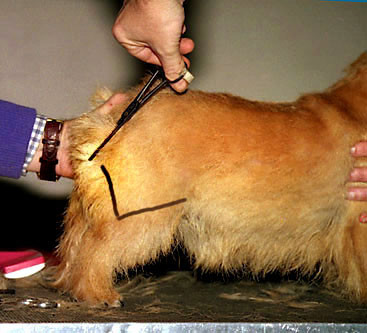

7. Trim under tail around anus with thinning scissors, then tidy in direction of coat.

8. Thin out dead hair from root to top upper side of tail with knife. Hold tail up, comb out and trim up the back, each side and straight across top to avoid a ‘flag’.
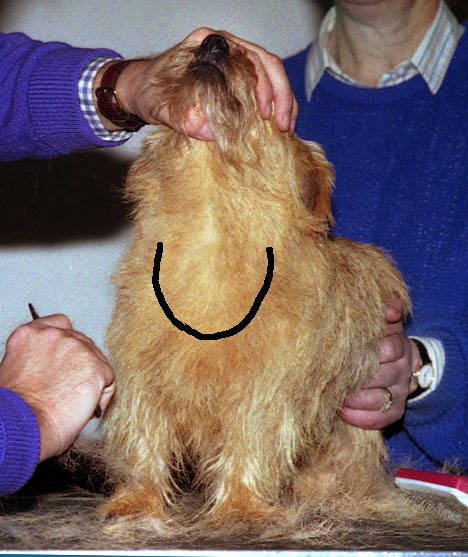
9. Take out by hand any long straggly hairs from the ruff around neck to neaten. The ruff frames the head and is mentioned in the Norfolk Terrier standard.
10. Strip with knife under the chin to the top of the breastbone forming a U shape.

11. With finger and thumb strip long pale hairs from ears inside and out and round edges, leaving a neat dark velvet appearance. The inside may be scissored especially around the ear hole.
12. With finger and thumb pull out any straggly long hairs that stick out above eyebrows and shape.

13. Hold ear up and clean neck below ear.

14. Comb out chin and trim from back to front (stand behind ears to do this).

15. Comb hair down under belly; hold thinning scissors at an angle and cut down each side. If a male dog, trim hair off end of penis to keep clean.

16. Cut hair on feet underneath, flat to pad, brush hair to foot, angle scissors and cut round foot.


17. Comb out ‘wings’ from elbows and cut downwards with thinning scissors – leave wider at the foot.
18. Trim nails.

19 Finished.
The photographs were taken during a hand stripping demonstration by Martin Phillips.
Our thanks to Martin and to the Club members whose writing on coat care over the last few years forms the basis of this guide.
Complied by Cherry Howard & Sally Willbie.


Tips on grooming from Rita Mitchell
When you first get your new puppy you probably haven't given grooming a thought but it pays off greatly for you and your Norfolk to start this early on. When people take their Norfolk along to a Groomer for its first strip they are often surprised to be told either the coat isn't ready to strip or that it was difficult to do the dog as it hated every bit and wouldn't co-operate!
You cannot strip (take out the coat) your Norfolk at just any time to suit you, the coat has to be ready for stripping, this means it is long, heavy and scruffy and is probably parting down the middle of the back. You need to wait until the dog is looking very untidy even when you’ve groomed it. You cannot take out the hair for a full strip as soon as it starts to look a little long or untidy - you have to wait. It nearly always goes a much lighter colour before it is ready to strip.
For a Full Strip you will have to wait at least 6 months and preferably 9 months or more in between stripping. 9 months is probably best but all coats are different.
If you want to have your dog looking great all the time then you have to learn the procedure of 'Rolling', this is where you go over the coat every few days constantly pulling all the 'blonde' longer hairs that stand out when you pick up a section between your fingers, you do this methodically moving over the whole body. Some coats are easy to do this with but some softer coats are much more difficult but it is possible to improve a coat with this method.
Back to when you first get your puppy, as soon as the puppy has settled in you can begin training for when he/she has that first strip either by you or a groomer. You need a steady table (one that does not wobble) or high surface to stand at to groom properly. It must have a non-slip surface, preferably a rubber mat (this can be bought by the yard/metre) or failing that a piece of carpet so that puppy feels secure and doesn't slide about. Make sure you have a firm hold on your puppy at all times (you don't want him to fall off). Don't groom your puppy on your lap or on the floor, he needs to get used to being on a table.
Teach your puppy just to stand still for a few minutes using the command 'stand' and stroking and talking to him. Then put the puppy back on the floor and reward him. Do this every day. After a couple of weeks you can start the grooming with a brush and do it for 5/10 minutes then put the puppy down again and reward him. Do this every few days. Also at this time get him used to you looking in his mouth, ears and picking up his feet and holding them one at a time. You can start trimming the nails at this time but just take off the very tip and do this regularly. Always hold on to the puppy when it is on the table as it has no idea of heights so might leap off the table and, if unlucky, break a leg.
Once the puppy is used to all this you can start pulling odd hairs to get him used to the feeling of this. You can pull the hairs on the outside of the ears every week and this will keep them looking like velvet and means there won't be bald patches when the dog has a full strip. Some puppies have had their 'baby coat' taken out by the breeder but if not you can do this yourself.

They look a bit like little hedgehogs - spiky looking hair that stands out, this can be pulled quite easily and is not like an adult coat. This is usually done around 8 -12 weeks old.
Talk to your puppy reassuringly all the time and always give a reward or lots of praise at the end. Don't have your puppy stand on the table too long to start with so that he is bored and becomes naughty, always keep the time short and finish on a happy note with the puppy being good when you end the session. As the puppy gets older you can increase the time. Always let your puppy go and play afterwards so it is all associated with fun.
There are several different tools for grooming/stripping which you can find at shows or on line or ask a groomer to show you. If you purchase a stripping knife (which isn't a knife but a blade with a serrated edge on a handle) it must be quite blunt before you use it, they come quite sharp when new. You can blunt it by cutting and sawing cardboard, this is to ensure the blade pulls the hair and doesn't just cut it - which you do not want.
Don't bath a Norfolk too often, they tend not to need bathing unless they have got dirty in something or have rolled in something which dogs love to do! Even if they are muddy - Terrier coats can be just brushed out after the mud has dried.
If you keep all this training up it will make life easier for you, your Norfolk and your groomer who will have to have your Norfolk stand and be trimmed for up to 2 hours for a full strip. Your dog will thank you for this when the time comes as he won't be upset and frightened by it all.
If you have an old Norfolk it might be easier to have him/her clipped or scissored rather than hand stripped as their skin seems to thin with age and it begins to hurt and also it is much quicker and kinder for them.
The Norfolk Terrier Club does hold grooming seminars where you will learn all the techniques with your own dog and you can study our photographs and description of hand stripping above.
Rita Mitchell, President Norfolk Terrier Club of GB. April 2012
